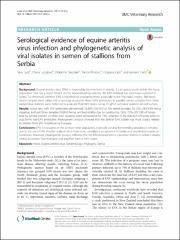| dc.contributor.author | Lazić, Sava | |
| dc.contributor.author | Lupulović, Diana | |
| dc.contributor.author | Gaudaire, Delphine | |
| dc.contributor.author | Petrović, Tamaš | |
| dc.contributor.author | Lazić, Gospava | |
| dc.contributor.author | Hans, Aymeric | |
| dc.date.accessioned | 2020-08-05T09:37:58Z | |
| dc.date.available | 2020-08-05T09:37:58Z | |
| dc.date.issued | 2017 | |
| dc.identifier.issn | 1746-6148 | |
| dc.identifier.uri | https://repo.niv.ns.ac.rs/xmlui/handle/123456789/283 | |
| dc.description.abstract | Background: Equine arteritis virus (EAV) is responsible for infections in equids. It can spread easily within the horse
population and has a major impact on the horse breeding industry. No EAV outbreak has ever been reported in
Serbia. To determine whether EAV is nonetheless circulating there, especially in the Vojvodina region, 340 horse
serum samples were subjected to serology testing to detect EAV antibodies. In parallel, semen samples from three
seropositive stallions were collected to evaluate their EAV status, using RT-qPCR and virus isolation on cell culture.
Results: Horse sera with EAV antibodies represented 15.88% (54/340) of the tested samples, 83.23% (283/340) being
negative, and just three samples (0.89%) being uninterpretable due to cytotoxicity. Only 7.2% (10/138) of horses
kept by private owners on their own property were seropositive for EAV, whereas 21.8% (44/202) of horses kept on
stud farms had EAV antibodies. Phylogenetic analysis showed that the Serbian EAV isolate was most closely related
to isolates from the neighbouring Hungary.
Conclusions: EAV is circulating in the Serbian horse population, especially among the breeding population certainly
due to the use of EAV shedder stallions since there is no surveillance programme in Serbia and only limited checks on
racehorses. Moreover, phylogenetic analysis indicates that the EAV isolated from a Lipizzaner stallion in Serbia is closely
related to isolates from Hungary, and together form a new cluster. | en_US |
| dc.description.sponsorship | This study was supported by the Hubert Curien Partnerships (PHC-Pavle
Savic), the European Reference Laboratory for Equine Diseases other than
African Horse Sickness, ANSES’s own institutional resources and the Ministry
of Science and Technological Development of the Republic of Serbia (Grant
no. TR31084). The funders had no role in study design, data collection and
interpretation, or the decision to submit the work for publication. | en_US |
| dc.language.iso | en | en_US |
| dc.source | BMC Veterinary Research | en |
| dc.subject | Horse | en_US |
| dc.subject | Equine arteritis virus | en_US |
| dc.subject | Epidemiology | en_US |
| dc.subject | Phylogeny | en_US |
| dc.subject | Serbia | en_US |
| dc.title | Serological evidence of equine arteritis virus infection and phylogenetic analysis of viral isolates in semen of stallions from Serbia | en_US |
| dc.title.alternative | BMC Veterinary Research | en_US |
| dc.type | Article | en_US |
| dc.identifier.doi | 10.1186/s12917-017-1226-x | |

